| . |
| . |
| . |
| . |
| . |
| The 1930s would continue to see the DSR rapidly expand its motorbus operation. Even though large-size buses were initially purchased, by mid-decade a massive move toward small-size (21-pass) buses would begin. In addition to its fixed-route motorbus service, during the early-thirties the DSR would also operate both scheduled and special service trips to the Ford Airport in Dearborn; across the Ambassador Bridge between the U.S. and Canada; and to the new Detroit City Airport which opened in 1930. A small fleet of parlor buses were purchased for these operations. |
| .. |
| . |
| 1930-39 EQUIPMENT PHOTOS (Page 3) |
| . |
© 2011 (PAGE LAST MODIFIED ON 09-22-11 (addition 08-16-12))
| . |
| . |
| . |
| . |
| . |
ACF "METROPOLITAN" GAS-ELECTRIC BUSES — MODEL 512-2-H8
| . |
| . |
| . |
| . |
By 1932, the DSR would see its motorbus
fleet increase to nearly 600 buses, many of
which included large-size Twins, ACFs and
Yellow Coaches purchased during the
mid-to-late 1920s. In 1934, a new general
manager would arrive who would change
the department's focus from large
streetcars to hundreds of small low-cost
buses using fast headways. Three styles
of buses sold by the Ford Motor Company
would dominate the DSR motorbus fleet by
the decade's end.
fleet increase to nearly 600 buses, many of
which included large-size Twins, ACFs and
Yellow Coaches purchased during the
mid-to-late 1920s. In 1934, a new general
manager would arrive who would change
the department's focus from large
streetcars to hundreds of small low-cost
buses using fast headways. Three styles
of buses sold by the Ford Motor Company
would dominate the DSR motorbus fleet by
the decade's end.
1936 Ford Metropolitan Coach (photo courtesy of Tom's Trolley Bus Pix)

| Please click-on link to return to the "PHOTO GALLERY" Main Page. |
LEASED BUSES FROM DETROIT MOTORBUS COMPANY
| In 1934, Fred A. Nolan would become general manager of the DSR. It would be under the reign of Nolan that the DSR would begin its movement toward an all-bus operation by 1953. Consequently, no new streetcars would be purchased; most streetcars lines would be replaced by buses on evenings and Sundays; thousands of new buses would be purchased; and the department would adopt a policy that was unique to the transit industry — the large-scale use of small-size buses with frequent headways, even on the more heavy patronized bus routes such as Dexter. |
DEPRESSION-ERA D.S.R. REBUILT DODGE-GRAHAM BUSES
| . |
| . |
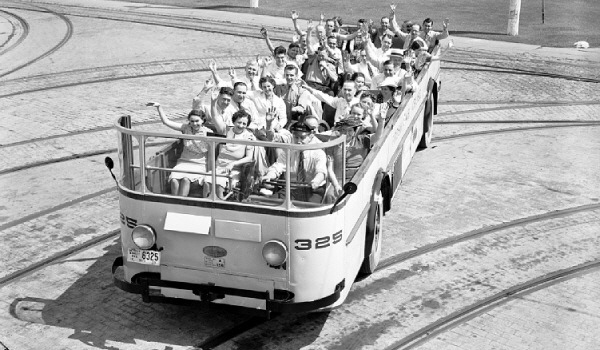
| After the ex-Detroit Motorbus (Model 40) Twin Coaches were retired, eight of the coaches had their tops removed and converted into "Fresh Air Cruisers." A total of ten cut-down Twins were used for special charters and 25¢ evening tours around Belle Isle. This Aug 1939 photo shows coach #325 (former DMB coach #1031) now operating as a cut-down fresh air cruiser. [Walter P. Reuther Library, Wayne State University photo #48423 — used with permission] |
| . |
| . |
FORD CONVENTIONAL STYLE COACHES
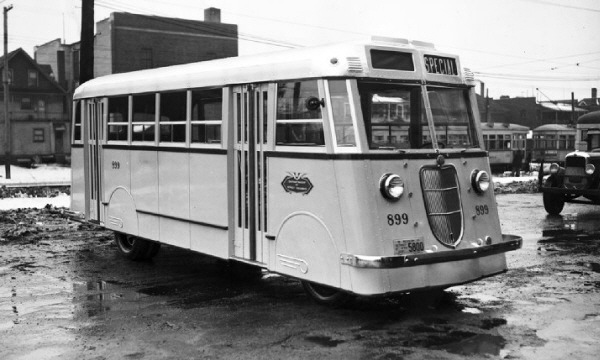
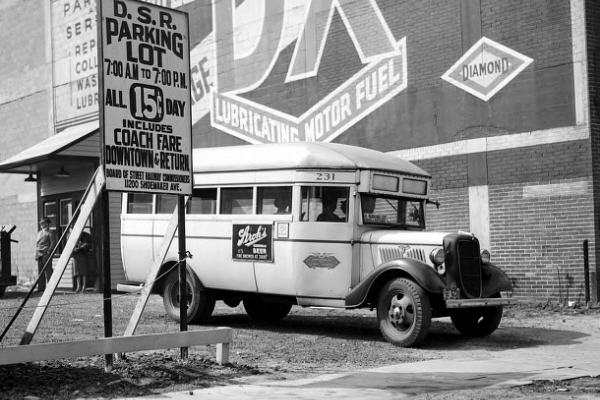
| The above photo shows coach #152—one of the last 100 conventional-type Fords (#151-250) delivered in late 1935—while at work on the Seven Mile route. The 5-cent fare displayed on the side of the coach was instituted in 1935 on bus routes that did not travel downtown. [photo courtesy of the S. Sycko photo collection] |
| Convinced that this type of bus was the answer to the department's economic woes, another 50 buses (#751-800) would arrive in July 1935. The DSR then attempted to purchase 100 similar looking buses mounted on lower-costing Chevrolet truck chassis. However, higher maintenance costs resulted in only 15 (#576-590) being purchased and the remainder of the Chevy order was cancelled and replaced by 85 Fords (#401-485). An additional fleet of 100 Fords (#151-250) were delivered in Dec 1935. In total, 331 conventional style Fords were purchased by the DSR. |
| The above photo shows the conventional Fords still going strong in 1939. In this May 12, 1939 photo, coach #231 is seen working the Ledyard Parking Lot bus line—a newly launched shuttle service from a parking lot at Second and Ledyard to downtown. The Fords were retired in 1944. [Walter P. Reuther Library, Wayne State University photo #29968 — used with permission] |
D.S.R. BUILT EXPERIMENTAL BUS #899
| Although the Fords proved to be more economical and a maintenance saver for the DSR, they still closely resembled the older style Graham buses first purchased during the mid-1920s, while bus design development in the industry was advancing in another direction. In July 1935, work began in the DSR Highland Park shops on an experimental "metropolitan or city service" bus to address some of those concerns. Utilizing a modified version of the same 157-inch Ford V-8 Model 51 truck chassis, a completely redesigned aluminum-alloy bus body was developed. Now equipped with a rear exit door, the coach also had air-operated doors and brakes. Both FoMoCo and Alcoa (Aluminum Company of America) consultants worked with the DSR in the coach's development. A completed coach #899 poses for this promotional photo in Feb 1936. [Walter P. Reuther Library, Wayne State University photo #10469_1 — used with permission] |
| . |
| (1930's D.S.R. Bus Fleet Not Pictured) In March 1930, two custom-built 15-passenger Lincoln (chassis) sedan model coaches (#10-11) were purchased for special service between downtown Detroit and the Ford Airport in Dearborn. In August 1930, one 29-passenger Yellow Coach #105-6E (Model Z-AAZ-326) was purchased by the DSR, bringing the total number of Yellow Coach buses purchased since 1926 to sixty-eight. Despite the trend in the transit industry toward larger 33-40 passenger coaches in larger cities, the DSR still experimented with smaller 21-31 passenger buses for possible purchase. Between 1929 and 1932, a number of small-size demonstrator coaches from various manufacturers were tested, including Cadillac, ACF (parlor coaches), Fargo Motor Corp., and Yellow Coach (GM). |
| . |
| DETROIT'S FORD MOTOR COMPANY BUS REIGN BEGINS |
FORD "METROPOLITAN" TRANSIT BUS
FORD "REAR-ENGINE" TRANSIT BUS
| . |
| . |
| FOOTNOTE: These Ford "Metropolitan" Transit Buses were featured in a DSR training film produced in 1937-38 in cooperation with Ford Motion Picture Laboratories. The film, which also shows these Fords at work along the streets of Detroit, can be viewed by clicking-on "Safe Coach Operation- Part 1" [photo source: Motor Coach Age Magazine – Mar-Apr 1992 edition (DSR Files photo)] |
| . |
| . |
| THE D.S.R.'s MOTOR-BUS FLEET AS DETROIT ENTERED THE NEW DECADE |
| . |
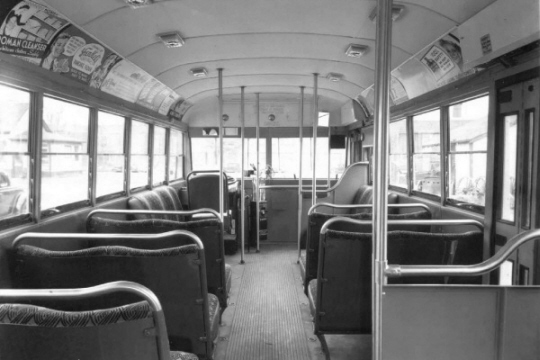
| This photo shows the interior view of a DSR 27-passenger rear-engine Ford Transit Bus. Some of the interior features promoted by Ford included 20-22 inch wide aisles, two-step entry and exit doors, 165 sq. ft. total floor space, a two-unit fresh air/hot water heating and ventilating system, and ribbed linoleum flooring along the aisle and steps. The primary interior color was a standard pea-green color commonly used on the Fords, Transits and Checkers that followed. [site-owner's collection photo, courtesy of the Schramm photo collection] |
| . |
| . |
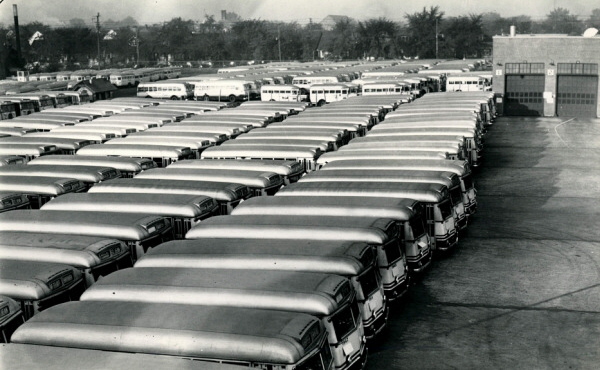
| In 1939, the Shoemaker Carhouse—the DSR's first storage and maintenance facility built by the city—was rebuilt into a bus garage to accommodate the department's growing bus fleet. With the arrival of the rear-engine Fords the last remaining larger-size ACF's, Twins, and Yellows were all retired. By 1940, the DSR's transit bus fleet totaled 1,597 coaches, of which 1,581 were Fords. The above photo shows all three styles of Ford buses parked at the Shoemaker bus garage. [photo source: online – unknown (unidentified) photo collection] |
| WE HOPE YOU'VE ENJOYED OUR 1930'S DSR EQUIPMENT PHOTO GALLERY |
| CLICK ON NEXT FOR THE 1940'S PHOTO GALLERY |
All Walter P. Reuther Library, Wayne State University photos posted with permission.
All rights, including those of further reproduction and/or publication, are reserved in full by the Walter P. Reuther Library, Wayne State University.
Photographic reproductions may be protected by U.S. copyright law (U.S. Title 17). The user is fully responsible for copyright infringement.
All rights, including those of further reproduction and/or publication, are reserved in full by the Walter P. Reuther Library, Wayne State University.
Photographic reproductions may be protected by U.S. copyright law (U.S. Title 17). The user is fully responsible for copyright infringement.
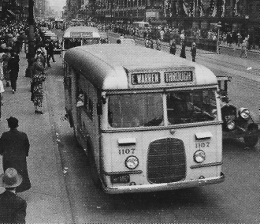
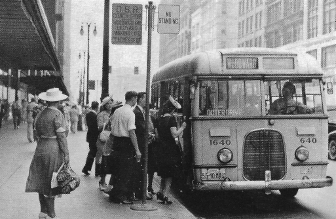
| By 1938, over 1,080 Fords (including 750 Transits) now dominated the DSR's motorbus fleet. These little Ford buses operating on quick headways could be found on mid-service routes such as Warren East with 1-2 minute rush hour headways (left photo), or heavy-service routes such as Dexter with 1-minute headways. In right photo, coach #1640 is seen boarding passengers in front of Hudson's while on the Woodward (supplemental) branch service to W. Seven Mile and Outer Dr. The last of the front-engine Ford Metropolitan Transit buses were retired in 1947. |
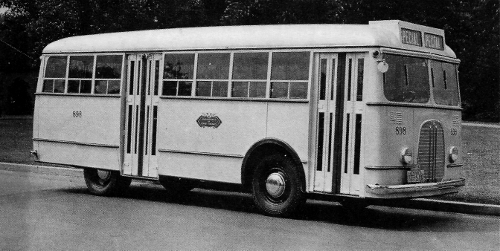
| The DSR's work on its experimental bus drew the attention of the Ford Motor Company. As a result, Ford engineers, in cooperation with the DSR, would completely redesign its bus product and develop a lightweight low-priced bus which Ford called its Ford Transit Bus. Ford engineers repositioned the engine and drive-train, shortened the wheelbase, and moved the front door ahead of the front axle. In June 1936, prototype coach #898 (above) was turned over to the DSR for testing. This demo would bring about the largest single bus order to date for Ford buses. [photo source: Motor Coach Age Magazine – Mar-Apr 1992 edition (Ford Archives Collection)] |
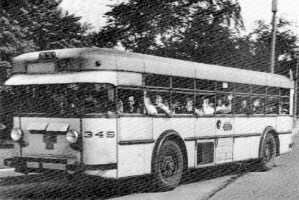
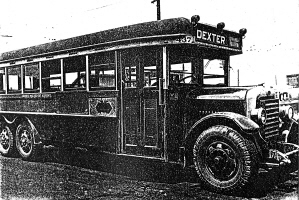
| Effective January 1, 1932, the privately-owned Detroit Motorbus Company's license to operate within the city of Detroit was revoked by the Common Council, and seven of its eight city routes were taken over by the DSR. To operate the added service the DSR immediately leased 92 DMB buses from the company's stockholders. The 92 leased ex-Detroit Motorbus coaches included: Thirty-two Twin Coach (1928-29 Model 40) buses (#1001-1032) initially leased and later purchased (left photo). The Twins were repainted and renumbered #319-350, and remained in service until 1940. In addition, sixty 27-passenger 1925-26 Safeway Six-Wheel Company built coaches (#400-numbered series) were leased until 1935 but never purchased (right photo). [DSR Files photos: MCA Magazine – Sept 1988 edition (left)/courtesy Ken Schramm (right)] |
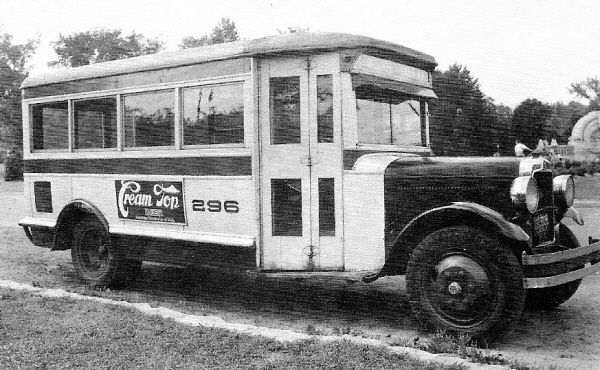
| Suffering from a sharp decline in ridership numbers as a result of the Depression, the DSR found itself low on funds to purchase new buses. In 1932, the DSR decided to extend the service lives on a number of its Dodge-Graham "Delux" parlor buses that were purchased in 1928 to replace the outlawed Jitneys. To accomplish this, the bodies from 36 older "city-type" Graham buses purchased between 1925-26 were refurbished and mounted on the chassis of the Dodge-Graham parlor buses. These rebuilt (21-pass) buses were renumbered #264-299 and placed into service in August 1932, sporting the DSR color scheme of cream and green trim. Fleet retired by 1937. [DSR Files photo, xerox photo copy courtesy of Kenneth Schramm] |
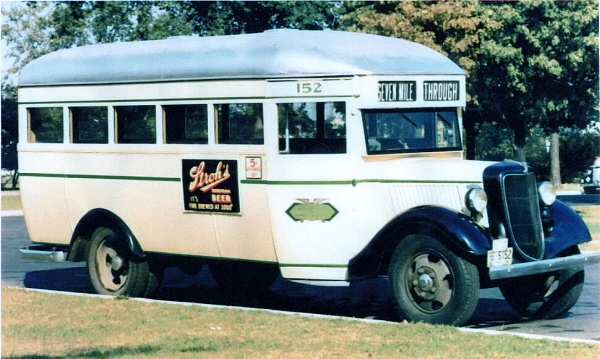
| With the DSR still feeling the grips of the Great Depression, General Manager Fred Nolan had become convinced that purchasing small low-cost buses made from mass-produced parts would reduce maintenance costs and offer the ability to provide frequent service. On March 20, 1934, the DSR ordered 35 buses from the Ford Motor Company. These 21-passenger buses were basically Ford truck chassis and motors mounted with bus bodies built by the Union City Body Co. of Union City, IN, where the final assembly of the bus was performed. The first 35 of these conventional style Fords (#801-835) began service on the Livernois line on July 1, 1934. |
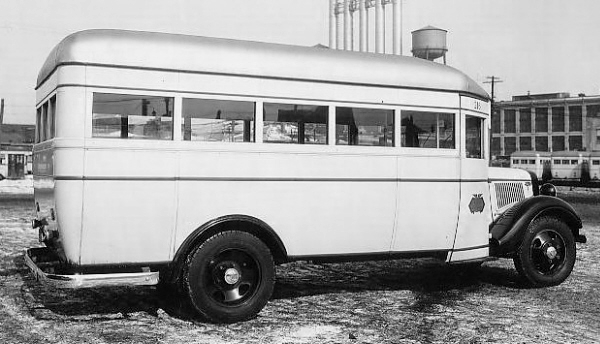
| The first of the low-cost conventional Ford buses—at $2,180 apiece—came equipped with Ford Model BB-18 truck chassis with 80-hp V-8 engines, and hydraulic brakes. A hand-operated door control was used to open the front door. Excess buses from the original order were also used on the Lafayette-Green line. In addition to an ex-demo (#836) obtained later in 1934, a second fleet of 60 coaches (#837-896) were purchased in early 1935 at $1,973 apiece, and were placed into service on the Fourteenth bus line. These buses were mounted on Ford Model 51 truck chassis with 85-hp V-8 engines. Proving to be a great success, additional Fords were on the way. [photo courtesy of the Carl D. Dutch photo collection] |
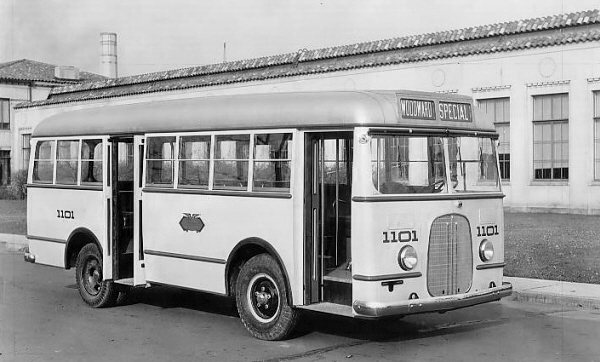
| DSR management was obviously pleased with the performance of pilot coach #898, and on October 28, 1936, placed an order for 500 of the new Ford "Metropolitan" Transit Buses. This 25-passenger forward control bus came equipped with a new bus-specific Ford Model 70 chassis with a 221-cubic-inch 85-hp V-8 Ford engine. Although now assembled at the Dearborn River Rouge plant, the newly designed bus bodies—fabricated in sections using an all-steel framework covered by an aluminum skin and a wood-framed padded rubber roof—were still supplied by the Union City Body Co. The first fleet of 500 coaches (#1051-1550) were delivered beginning November 27, 1936, as part of the 1937 model year production. Coach #1101, the first Transit Bus delivered to the DSR, poses outside the Ford Engineering Laboratory in Dearborn. [photo courtesy of the Carl D. Dutch photo collection] |
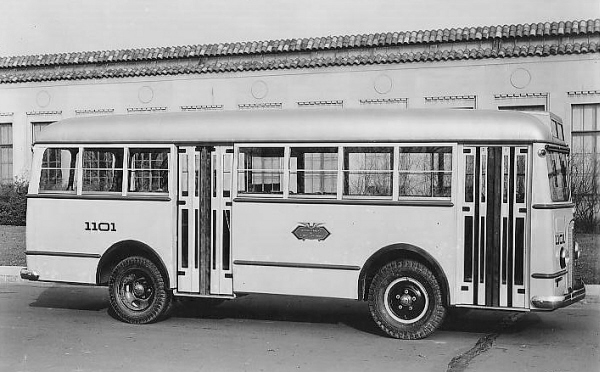
| One year after the first fleet of 500 Ford Transits were ordered, a second order for 250 Transits was made on October 19, 1937, at a cost of $3,677 apiece (compared to $2,890 each in first order). Delivery began on the second fleet (#1551-1800) on November 22, 1937, as part of the 1938 model year's production. Although identical to the first fleet, Ford revised its chassis model number system, and this fleet was identified by chassis Model 81-B ("8" for 1938 model year, "1" for 221-cubic-inch V8 engine and "B" for bus). Of the nearly 1,000 front-engine Transit Buses sold by Ford, 750 were purchased by the DSR (Ford's largest bus customer). [photo courtesy of the Carl D. Dutch photo collection] |
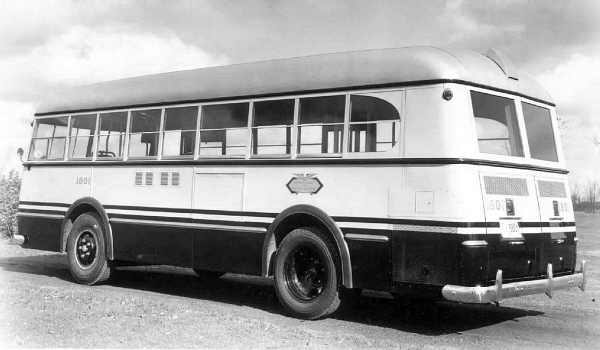
| In addition to lengthening the coach's wheelbase to 148½-inches and increasing its length to 309-inches, Ford also installed a larger 239-cubic inch 95-hp V-8 engine at the rear. As a part of the 1940 model year's production, this fleet was identified as chassis Model 09-B ("0" for 1940 model year, "9" for 239-cubic-inch V8 engine and "B" for bus). With the arrival of the 500-fleet rear-engine Fords, the last of the older larger-size buses would see retirement. [site-owner's collection photo, courtesy of the Schramm photo collection] |
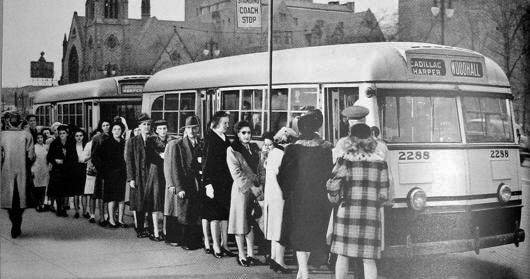
| In this photo, DSR Ford Transit coach #2288 can been seen working the Cadillac-Harper line while boarding passengers at the start of the route along Woodward in Grand Circus Park. According to DSR literature, wait time on Cadillac was reduced from 5 to 1¼ minutes during rush hours and from 12½ to 5 minutes during off-peak hours after the small-size Fords replaced the "big lumbering vehicles formerly used." The last of these coaches were retired in 1950. [Ford Transit Buses, Inc. promotional photo courtesy of Tom's Trolley Bus Pix-Detroit stuff] |
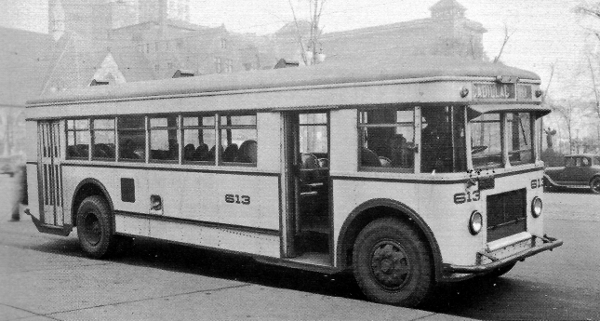
| Starting in October of 1930, the DSR received 50 locally-built American Car & Foundry (ACF) underfloor-engine "Metropolitan" gas-electric coaches #601-650. These 37-passenger coaches (Model 512-2-H8) cost $11,878 apiece and brought the total number of large size gas-electric coaches purchased by the DSR since 1926 to 142 (including 50 ACF double-decks). Despite the fact that bus design development was moving toward larger buses—which the DSR was using on its heavier routes—this ACF built fleet would become the last large-size buses to be purchased 'new' by the DSR until after WW-II. The last of these ACF coaches were retired in 1939. [photo source: Motor Coach Age Magazine – Jan-Feb 1991 edition (Schramm Collection)] |
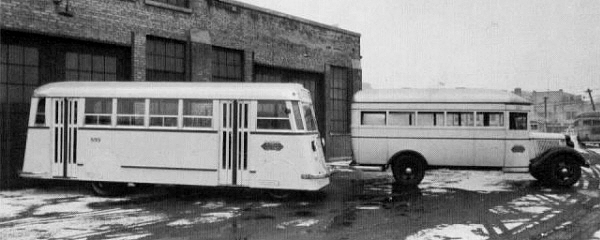
| Experimental coach #899 was turned over for service on April 22, 1936. This photo shows the new experimental coach posing along-side one of the DSR's conventional style Ford buses. Both vehicles seated 21-passengers. Coach #899 would remain in service until January 5, 1943, when it was then converted into DSR service truck #5376. [photo source: Detroit's Street Railways – Vol. II: City Lines 1922-1956 (DSR Files photo)] |
| . |
| The above photo shows coach #152 — one of the last 100 conventional-type Fords (#151-250) delivered in late 1935 — while at work on the Seven Mile route. The 5-cent fare displayed on the side of the coach was instituted in 1935 on bus routes that did not travel downtown. |
| . |
| The above photo shows the conventional Fords still going strong in 1939. In this May 12, 1939 photo, coach #231 is seen working the Ledyard Parking Lot bus line—a newly launched shuttle service from a parking lot at Second and Ledyard to downtown. The Fords were retired in 1944. |
| . |
| FOOTNOTE: These Ford "Metropolitan" Transit Buses were featured in a DSR training film produced around 1937-38 in cooperation with Ford Motion Picture Laboratories. The film, which also shows these Fords at work along the streets of Detroit, can be viewed by clicking-on "Safe Coach Operation- Part 1" |
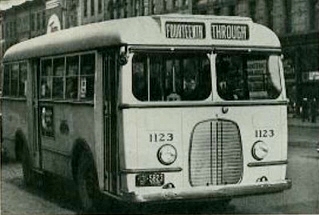
| . |
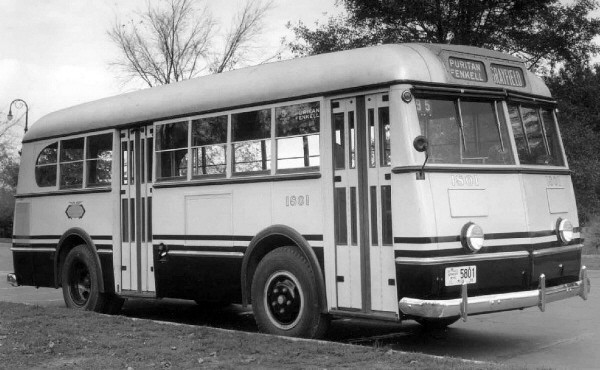
| Delivery of the 500-coach order for the new Fords (#1801-2300) began on November 4, 1939. The completely redesigned bus bodies were still being supplied by the Union City Body Co. of Union City, Indiana, and still topped by a wood-framed padded rubber canvas roof. The series coach #1801 poses in this photo while also sporting the new DSR paint scheme of cream and black trim with a silver color roof. These new DSR Transits were nicknamed the "black bottom" Fords because of the black-bottom paint scheme now found along their lower skirt. [site-owner's collection photo, courtesy of the Schramm photo collection] |
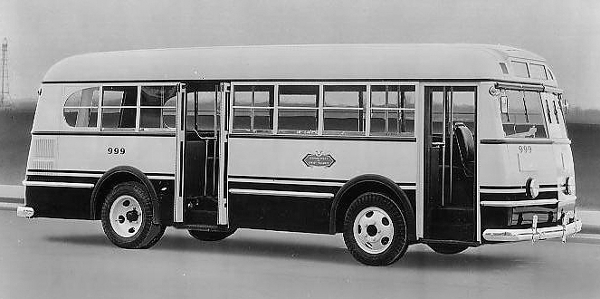
| But it soon became evident that the front engine placement on the forward-control Transits not only made it difficult to service and replace the engines, but also resulted in weight distribution problems during heavy loads. In early 1939, Ford introduced its new redesigned Transit Bus equipped with a new improved engine installed transversely at the rear. On February 17, 1939, prototype coach #999 was delivered to the DSR for testing and returned on June 19, 1939. This demo led to the DSR's first order for the new (27-passenger) Ford "Rear-Engine" Transit Bus. [photo courtesy of the Carl D. Dutch photo collection] |
| THE 1990's 1 2 3 |
| THE 2010's 1 2 |
| THE 2000's 1 2 |